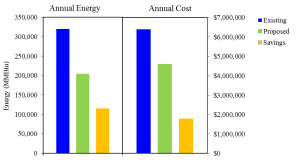Project Overview
Abraxas Energy Consulting conducted a facility energy assessment (EA)) project for the VA Medical Center in Palo Alto, California in August 2014. There were 22 buildings in the scope of this project at the facility, 7 major and 14 minor buildings, encompassing a total of 1,080,712 square feet. The purpose of the EA program was to assist the VA Department in identifying cost effective energy and water conservation measures and thus fulfill the goal of reducing energy costs and the greenhouse gas footprint of this VA campus.
Objectives
Key project requirements were identified and are outlined below:
1. Benchmark the facility and establish a consumption baseline.
2. Identify and quantify energy conservation measures (ECMs) and make recommendations to reduce energy and water usage.
3. Fulfill requirements and comply with all laws, executive orders, regulations, and standards related to the Energy and Water Management Program and other regulatory requirements for federal facilities.
The Solution
A site visit was required to gather information to perform the study. The on-site assessment included reviewing building and equipment data, interviewing site personnel, observing energy related equipment operation and conducting limited site measurements. Following the site visit, the energy assessment was developed in two phases.
Phase 1 consisted of a utility bill audit which established a baseline for energy and water usage and facilities benchmarking using Energy Star Portfolio Manager. Twenty-four months of bills for water, natural gas and electricity were used to conduct the audit. This generated a baseline for the energy and water usage that was later used in calculating potential energy savings. Baselines by building were also calculated for the six major buildings. These 6 buildings account for 75% and 48% of the total amount of energy and water consumed, respectively. The Energy Star score for the campus used to benchmark the facility was 21. The calculated HDDs and CDDs provided insight to potential energy conservation measures.
Phase 2 had the purpose of identifying and quantifying ECMs and WCMs. A list of 34 ECMs, categorized into different project categories, was proposed. A list of other significant findings regarding incentives, the use of cogeneration, renewable energy sources or bio-fuels or other operation and maintenance measures were also reported.
The Results
Identified ECMs were classified in several categories: air handlers, chilled water and air conditioning systems, boiler systems, exterior lighting, interior lighting, building controls, plumbing systems and water conservation, renewables and other. The largest opportunities for savings were found on decommissioning the central steam plant and installing boilers at buildings, increasing capacity of on-site solar PV generation, replacing boilers with modular, high efficiency boilers, implementing a supply air reset on AHUs and replacing old air-cooled chillers. Other ECMs providing large savings were implementing unoccupied setpoints for select zones, implementing chilled water reset, retrofitting parking garage lighting with bi-level LED fixtures and upgrading interior lighting to LED fixtures. Studies were also conducted into the feasibility of co-generation and renewable energy sources. These were preliminary assessments and based on the results, renewable energy sources were not found to be cost effective. The viability of cogeneration for VAMC Palo Alto will have to be studied with more detail on a further analysis. The existing and proposed annual energy usage and cost for this project are shown below.
Benefits
When implemented, the ECMs will save over $1,745,357 per year with an overall payback of 11.57 years. Total savings for electricity is 6,412,562 kWh/yr, for gas the savings is 915,480 Therm/yr, and for water savings is 1,180 MGal/yr. The ECMs are estimated to achieve energy savings of 35% and water savings of 2.1% with respect to the calculated baselines. All values were evaluated using bin simulations and spreadsheet calculations based upon standard energy savings estimating methods and known and assumed operating conditions.
Figures ES-1 presents the baseline, proposed, and savings in energy usage and costs.
Figure ES-1
Summary of Existing and Proposed Annual Energy Usage and Cost

